|
Notes: Tue Brook station was situated on the London & North Western Railway (LNWR) Canada Dock branch which ran from Edge Hill to Canada Dock. The line was authorised in 1860 and its primary purpose was to give the LNWR access to the most northerly of the Liverpool Docks. The LNWR had goods stations at Wapping Dock (opened October 1830) and at Waterloo (opened 1 August 1849) but since those stations had opened the docks had continued to spread northwards. The Canada Dock branch did not take a direct course from Edge Hill to Canada owing to the topography of the area. It ran in a north/south direction through Tue Brook at a distance of about 2 miles from the river front. Only when it reached Anfield (north of Tue Brook) did it start to turn towards the west and head down to the docks.
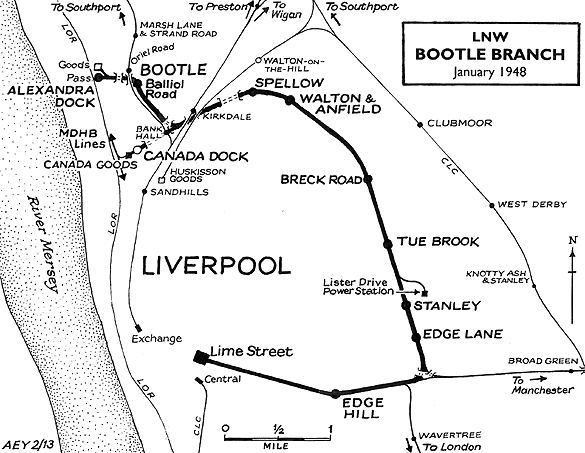 |
The double-track line opened in two stages, the first being from Edge Hill to Tue Brook on 1 June 1866. Tue Brook station opened with the first section of the branch. It was located on an embankment on the north side of West Derby Road. Each of the two platforms was linked to the street by wooden stairways. Initially open to the elements the stairways were enclosed with walls and a roof by 1900.
Both platforms were constructed with a brick face and they were paved with stone flags. The main facilities where located on the up platform (Liverpool Lime Street direction). They were housed in a single-storey timber structure with a hipped roof. A flat awning with a serrated valance sheltered the platform. On the down platform (Canada Dock direction) there was, in the early days, just a simple waiting shelter but a larger building in a similar style to that on the up platform had been provided by 1900.
 Goods facilities were provided on the south side of West Derby Road on the west side of the line. They consisted of a goods office, a weighing machine and a 2-ton lifting crane. There were three sidings situated on an embankment. A roadway connected the sidings to West Derby Road. There were a further two sidings on the east side of the main line. Goods facilities were provided on the south side of West Derby Road on the west side of the line. They consisted of a goods office, a weighing machine and a 2-ton lifting crane. There were three sidings situated on an embankment. A roadway connected the sidings to West Derby Road. There were a further two sidings on the east side of the main line.
At the time of opening passenger services ran between Liverpool Lime Street and Tue Brook calling at all stations of which there were two others on the branch (at Stanley and Edge Lane).
On 15 October 1866 the line was opened from Tue Brook to Canada Dock but only for goods services. The passenger service continued to run only between Lime Street and Tue Brook until 1 July 1870 when a passenger station opened at Canada Dock. Intermediate stations were also provided at Breck Road and at Walton.
On 5 September 1881 a line was opened from Atlantic Dock Junction (just to the east of Canada Dock) and Alexandra Dock. Passenger trains ran along the new line between Alexandra Dock and Liverpool Lime Street. Down services from Tue Brook alternated equally between Canada Dock and Alexandra Dock.
An LNWR Type 4 signal box opened at Tue Brook in 1881 north of the up platform.
A horse tramway opened along West Derby Road in the 1880s which competed with the railway.
The December 1895 timetable showed 30 up and 31 down trains on weekdays. For much of the day Tue Brook had a half-hourly service. All of the up services ran to Liverpool Lime Street and the down services were still split roughly equally between the two northern termini.
On 21 October 1900 electric trams were introduced onto the tramway. A frequent service linked Tue Brook to the city centre via a much more direct route and they competed more effectively than the horse trams for passengers. The competition resulted in a reduced passenger train service.
The Canada Dock branch was a very busy freight railway and during the Great War it handled huge volumes of war-related traffic as Liverpool had become the major west-facing port.
 By July 1922 the passenger service had been reduced to 18 up and 19 down services. The down service pattern had also altered, there being only five services to Canada Dock but 14 to Alexandra. By July 1922 the passenger service had been reduced to 18 up and 19 down services. The down service pattern had also altered, there being only five services to Canada Dock but 14 to Alexandra.
On 1 January 1923 Tue Brook became part of the London Midland & Scottish Railway (LMS). The LMS summer timetable for 1932 showed five trains from Tue Brook to Canada Dock, 12 trains to Alexandra Dock and 17 to Liverpool Lime Street on weekdays only.
The outbreak of the Second World War on 3 September 1939 meant that once again the Canada Dock branch had a key role to play. However Liverpool found itself in the direct line of fire and suffered heavy bombing from December 1940. On 4 May 1941 the station at Canada Dock was very badly damaged. The goods warehouse was completely destroyed by fire and the passenger station was flooded as the Leeds & Liverpool canal had been breached by a bomb. Passenger services to Canada Dock were suspended and they were never reintroduced. Tue Brook was left with the Liverpool Lime Street – Alexandra Dock service.
The summer 1947 timetable showed a much reduced service of only five trains to Alexandra Dock, one to Spellow and six to Liverpool Lime Street on Monday-to-Friday only.
On 1 January 1948 Tue Brook became part of British Railways [London Midland Region]. As a passenger station it did not survive long after Nationalisation, closing on 31 May 1948. A passenger service between Liverpool Lime Street and Spellow (the last station before Atlantic Dock Junction, opened in September 1882) was shown in the Summer 1949 timetable with only one train in each direction. It is not known if the service actually ran and it did not serve Tue Brook.
The passenger station was demolished shortly after closure and, being a timber structure, little trace remained.
 Tue Brook signal box closed on 20 December 1953. It was replaced by a Midland Type 4d type box that fitted with a BR[LMR] 20-lever frame. The replacement box was located on the down side of the line opposite the site of the original one. Tue Brook signal box closed on 20 December 1953. It was replaced by a Midland Type 4d type box that fitted with a BR[LMR] 20-lever frame. The replacement box was located on the down side of the line opposite the site of the original one.
The goods facilities at Tue Brook remained open after the local passenger service had been withdrawn and they did not close until 27 November 1967. Tue Brook signal box closed on Sunday 17 October 1976.
Passenger services continued to pass through Tue Brook after the withdrawal of the local service in the form of through coaches between Southport and Edge Hill. The coaches were attached to/detached from Liverpool – London Euston services. In the second half of the 1960s the through coaches were replaced by DMUs which ran until 9 October 1977.
In 2017 there was no trace of the station but the line remained busy with freight trains.
Timetable from Paul Wright, ticket from Michael Stewart and route map by Alan Young
Sources:
To see the other stations on the Canada Dock branch click on the station name: Canada Dock, Spellow, Walton & Anfield, Breck Road,
Stanley & Edge Lane
See also Alexandra Dock branch stations:
Bootle Balliol Road and Alexandra Dock (LNWR)
See also:
Canada Dock Goods and Atlantic Dock Junction
|

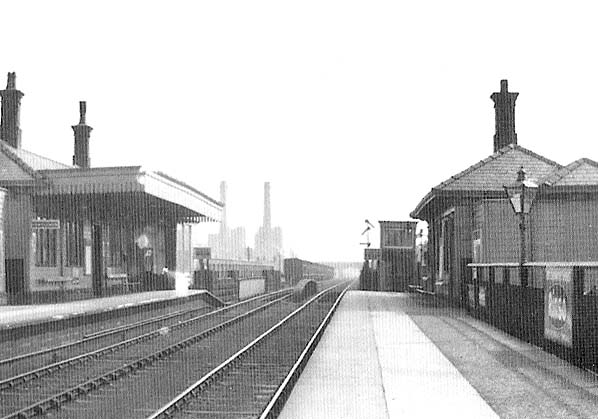
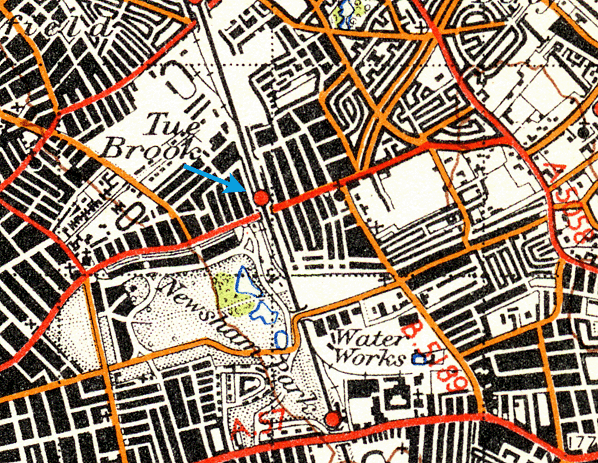

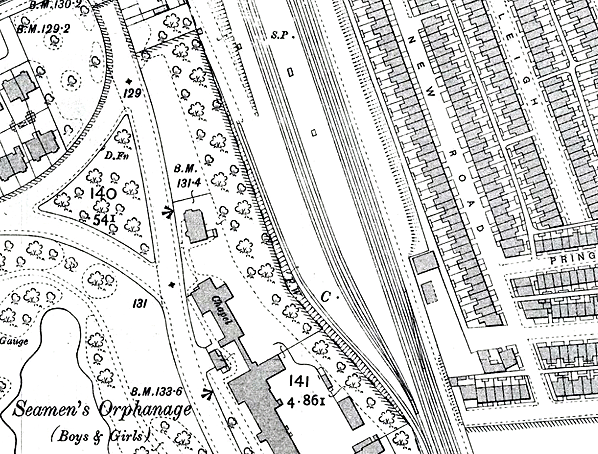
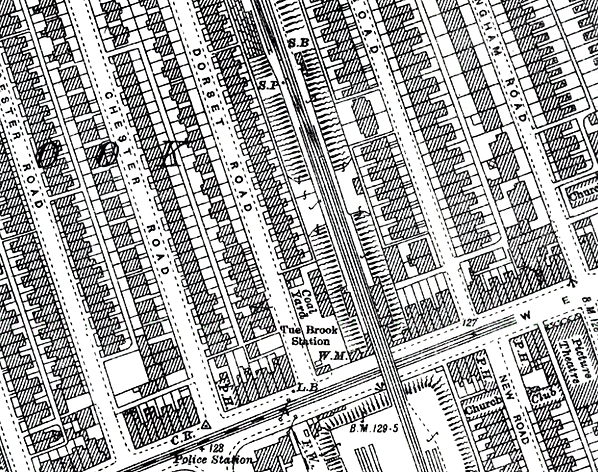
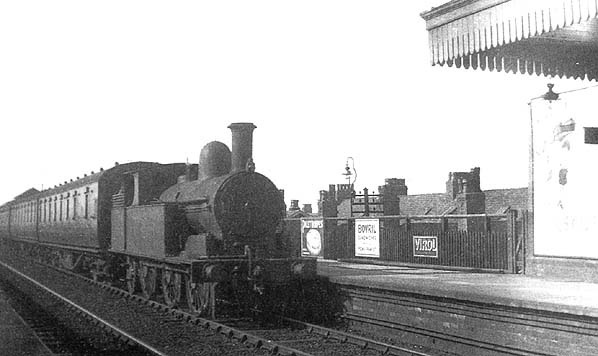
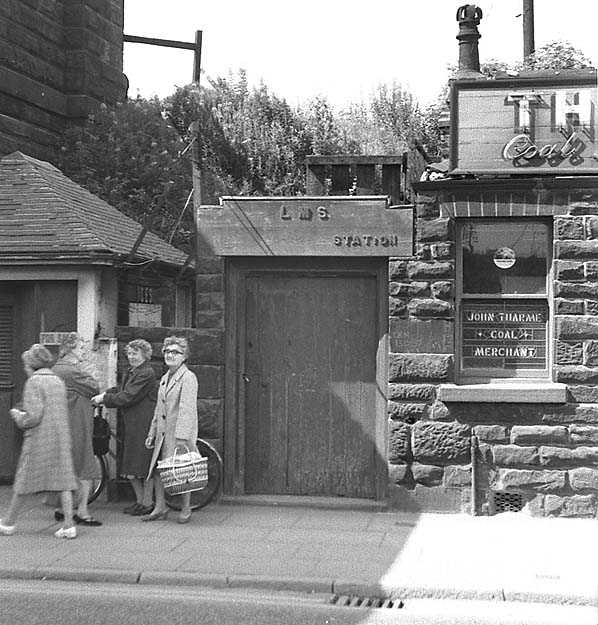
.jpg)
.jpg)
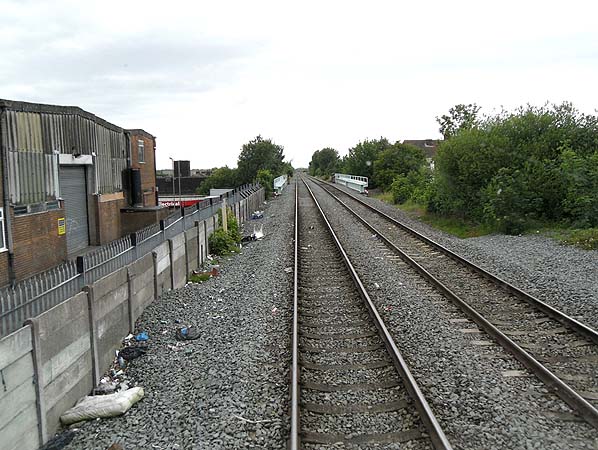
 Home Page
Home Page 
 Goods facilities were provided on the south side of West Derby Road on the west side of the line. They consisted of a goods office, a weighing machine and a 2-ton lifting crane. There were three sidings situated on an embankment. A roadway connected the sidings to West Derby Road. There were a further two sidings on the east side of the main line.
Goods facilities were provided on the south side of West Derby Road on the west side of the line. They consisted of a goods office, a weighing machine and a 2-ton lifting crane. There were three sidings situated on an embankment. A roadway connected the sidings to West Derby Road. There were a further two sidings on the east side of the main line.  By July 1922 the passenger service had been reduced to 18 up and 19 down services. The down service pattern had also altered, there being only five services to Canada Dock but 14 to Alexandra.
By July 1922 the passenger service had been reduced to 18 up and 19 down services. The down service pattern had also altered, there being only five services to Canada Dock but 14 to Alexandra. 
 Tue Brook signal box closed on 20 December 1953. It was replaced by a Midland Type 4d type box that fitted with a BR[LMR] 20-lever frame. The replacement box was located on the down side of the line opposite the site of the original one.
Tue Brook signal box closed on 20 December 1953. It was replaced by a Midland Type 4d type box that fitted with a BR[LMR] 20-lever frame. The replacement box was located on the down side of the line opposite the site of the original one. 